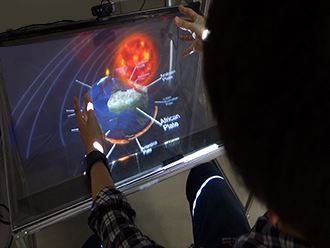Emerging Technologies
|
FCFull Conference Pass (FC - All Days)
FC1Full Conference Pass (FC - 1-Day Only)
BCBasic Conference Pass
ExExhibits Only
ETElectronic Theater Ticket
RTReception Ticket
|

R2D2 w/ AIRR: Real time & Real space Double-Layered Display with Aerial Imaging by Retro-Reflection
We present a double-layered display based on Aerial Imaging by Retro-Reflection (AIRR) and transparent tabletop display. AIRR is a lens-less re-imaging technique, hence provides wide-view-angle, scalable floating images with affordable costs. Despite such advantages, AIRR has been paid little attention as a re-imaging technique because it has serious limitations of low light efficiency and low resolution to visualize a floating image in a standard lighting condition. We first introduce the optical solution to improve the light efficiency and the resolution by deploying polarization recycling technique and high retro-reflective full corner cube array. The improved design can display two and half times brighter floating images and, as a result, enables any users to implement their own floating display by simply re-imaging a standard brightness LCD display. To further explore the unique strengths of AIRR, we introduce double-layered displays, which can superimpose a floating image over a transparent tabletop projection screen as a background. We present two methods: temporal multiplexing method and spatial multiplexing method. Temporal multiplexing method employs a 120Hz 3D projector and two switchable LCD panels, PNLC. The 3D projector presents a floating image and a tabletop image to corresponding PNLC panels time-sequentially. User can see both images virtually concurrently by visual persistence. Spatial multiplexing method is designed for a large scale double-layered display. It places a transparent holographic projection film on top of the beam splitter and projects a tabletop image from the top. With a little interference, user can watch a floating image over a tabletop image. The resulted two and half dimensional space releases users from the constraints of tabletop display and expands horizons of spatially augmented experience with a table-touch interaction and a mid-air gesture interaction.
Presenter(s)
Yutaka Tokuda, Center for Optical Research and Education, Utsunomiya University, The University of Tokyo
Atsushi Hiyama, The University of Tokyo
Michitaka Hirose, The University of Tokyo
Hirotsugu Yamamoto, Center for Optical Research and Education, Utsunomiya University

